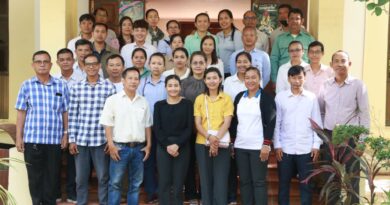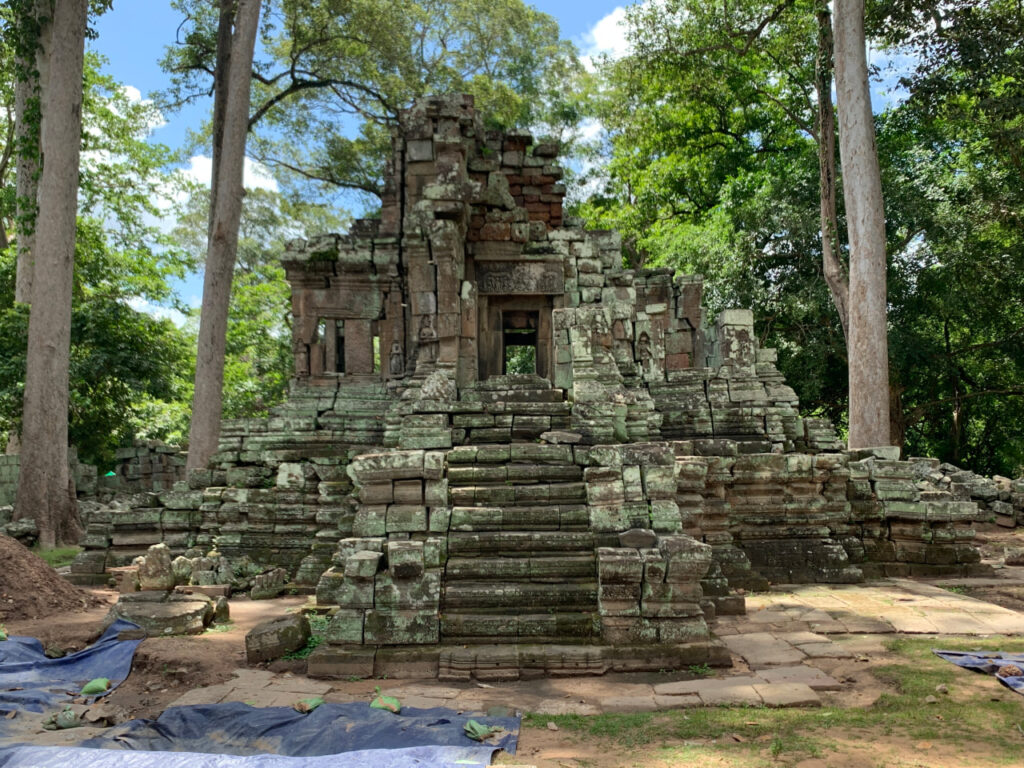អាជ្ញាធរជាតិអប្សរា សហការជាមួយទីភ្នាក់ងារសហប្រតិបត្តិការអន្តរជាតិកូរ៉េ(KOICA) តាមរយៈមូលនិធិបេតិកភណ្ឌកូរ៉េ(KCHF)កំពុងជួសជុលប្រាសាទជម ដែលទទួលរងការខូចខាតធ្ងន់ធ្ងរឱ្យរឹងមាំឡើងវិញតាមបច្ចេកទេសអាណាស្ទីឡូស(Anastylosis) រុះរើតួរបស់ប្រាសាទដើម្បីជួសជុលពង្រឹងគ្រឹះ ពង្រឹងរចនាសម្ពន្ធពាក់ព័ន្ធផ្នែកខាងក្រោម ព្រមទាំងជួសជុលថ្មដែលបាក់ខូច និងរៀបផ្គុំតួប្រាសាទជាថ្មីឡើងវិញ ដោយរក្សាឱ្យបាននូវទម្រង់ដើមទាំងស្រុង។
ស្ថាបត្យករនៃអាជ្ញាធរជាតិអប្សរា លោក ថៃ យ៉ាម៉ង់ ឱ្យដឹងថា គម្រោងជួសជុលប្រាសាទជម បានចាប់ផ្តើមនៅឆ្នាំ២០១៩ ដោយជំហានដំបូងបានធ្វើកំណាយស្រាវជ្រាវ វាយតម្លៃការខូចខាត ធ្វើសម្រង់ប្លង់និងស្វែងរករកឯកសារ និងរូបភាពចាស់ៗសម័យបារាំង ព្រមទាំងរុះរើថ្មតាមបច្ចេកទេសអាណាស្ទីឡូស ដោយបែងចែកជា២ដំណាក់កាល។ ថ្មដែលរើមានចំនួន៣៥ស្រទាប់ ដោយថ្មភក់ចំនួន៣៥៨០ដុំ និងថ្មបាយក្រៀមមាន៤១០០ដុំ។ លោក យ៉ាម៉ង់ ឱ្យដឹងទៀតថា ចំពោះការពង្រឹងគ្រឹះដែលស្រុតឱ្យរឹងមាំឡើងវិញ នៅតាមកន្លែងខូចខាតនានាត្រូវផ្លាស់ប្ដូរថ្មបាយក្រៀមថ្មី និងបច្ចុប្បន្ននេះ កំពុងរៀបសាកល្បងកម្រាល ដើម្បីឈានទៅដល់ការរៀបផ្គុំខឿនរបស់ប្រាសាទទាំងមូលឡើងវិញ។
ស្ថាបត្យកររូបនេះបញ្ជាក់ទៀតថា ថ្មដែលរលុះធ្លាក់ផ្នែកខាងលើបានរកឃើញប្រមាណ៣០ភាគរយ ហើយថ្មមួយចំនួនបានរងការខូចខាតដែលទាមទារការជួសជុល និងព្យាបាលដោយយកចិត្តទុកដាក់។ ជាមួយគ្នានេះដែរ ការស្វែងរកថ្មនៅប្រាសាទជម មានការលំបាកក្នុងការផ្គុំឡើងវិញ ដោយសារគំនរថ្មខ្លះមានលាយឡំគ្នាជាមួយថ្មប្រាសាទផ្សេងទៀតដែលនៅជុំវិញ។
ស្ថានភាពរបស់ប្រាសាទជម ផ្នែកកំពូលនៃប្រាសាទត្រូវបានរលុះធ្លាក់ កន្លែងខ្លះទៀតហែកក្រៀក ថ្មស្ទើរតែបាត់បង់រូបរាងដើម បណ្តាលមកពីអាយុកាលនៃសំណង់ កត្តាសង្រ្គាម កត្តាកង្វះការថែទាំយូរអង្វែង និងកត្តាធម្មជាតិ ដូចជាឬសឈើចាក់បំបែករចនាសម្ពន្ធរបស់ប្រាសាទរហូតទៅដល់ដីគ្រឹះ ធ្វើឱ្យទឹកភ្លៀងហូរចូល នាំឱ្យដីគ្រឹះចុះខ្សោយនិងធ្វើឱ្យស្រុតចុះ ថែមទាំងទ្រេតចំនួន៦ដឺក្រេ។ ក្រុមការងាររំពឹងថាគម្រោងជួសជុលប្រាសាទជម អាចនឹងបញ្ចប់នៅឆ្នាំ២០២៥ខាងមុខ៕
អត្ថបទ: យី សុថា
រូបភាពះ លោក ភោគ ជា និងលោក ថៃ យ៉ាម៉ង់
APSARA National Authority cooperates with the Korea International Cooperation Agency (KOICA) through the Korea Cultural Heritage Foundation (KCHF) to restore the Chorm temple using the Anastylosis technique, dismantling the temple structure to repair the foundation, strengthening the lower structures, as well as repair the broken stones, and reassembling the temple to its original form.
The architect of the APSARA National Authority, Mr. Thai Yamang, said that the project to restore the Chorm temple began in 2019, the first step was to excavate, research, assess the damage, make a plan, and find old documents and pictures from the French era, as well as dismantling the stone with Anastylosis technique, which divided into two stages. There are 35 stone layers, with 3,580 pieces of sandstone and 4,100 pieces of laterite. He added that for the strengthening of the foundations that collapsed in the damaged areas need to be replaced with new laterite and we are currently testing to restore the floor, and then reach the reassembly of the entire temple.
Mr. Thai Yamang added that about 30 percent of the stones that fell from the top were found and some of the stones were damaged, which required careful repair and treatment. Also, finding stones at Chorm temple is difficult to reassemble because some piles are mixed with other surrounding stones.
The condition of the Chorm temple, the top part of the temple has been torn down, some parts have been torn apart, and it has almost lost its original shape due to the age of the construction, war factors, lack of long-term maintenance, and natural factors such as the tree roots grow into the temple, the rainwater flows to the foundation, weakening it and causing it to collapse and tilt 6 degrees. The team expects that the project to restore the Chorm temple may be completed in 2025.
Article: Yi Sotha
Photos: Phouk Chea / Thai Yaman
Share:
Our Latest News

អាជ្ញាធរជាតិអប្សរា បើកវគ្គសិក្ខាសាលាស្តីពី៖ ការពង្រឹងសមត្ថភាព ស្តីពីការរៀបចំរបាយការណ៍បច្ចេកទេស ជូនមន្ត្រី-បុគ្គលិកពាក់ព័ន្ធ- Workshop on Capacity Building for Technical Report Preparation- 05 May 2025
ពុទ្ធបរិស័ទចំណុះប្រាសាទវត្តអធ្វា បានរៀបចំកិច្ចពិធីឡើងអ្នកតា ៣កើត ខែពិសាខ និងកិច្ចពិធីបញ្ជូនអ្នកតាឡើងគោក ដែលជាទំនៀមពីបុរាណកាលមក។ ពិធីនេះដូចពិធីឡើងអ្នកតា នៅថ្ងៃ៣កើត ខែមាឃដូច្នោះដែរ គ្រាន់តែនៅខែមាឃ គឺគេបញ្ជូនអ្នកតាចុះទឹក ដែលបញ្ជាក់ពីការបញ្ចប់វដ្ដរដូវធ្វើស្រែ។




